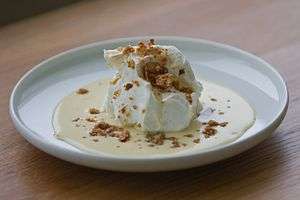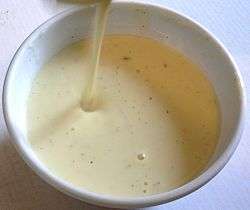Floating island (dessert)
A floating island is a dessert of French origin, consisting of meringue floating on crème anglaise (a vanilla custard). The meringues are prepared from whipped egg whites, sugar, and vanilla extract then quickly poached. The crème anglaise is prepared with the egg yolks, vanilla, and hot milk, briefly cooked.
 | |
| Alternative names |
|
|---|---|
| Course | Dessert |
| Place of origin | France |
| Main ingredients | meringue (egg whites, sugar and vanilla extract), crème anglaise (egg yolks, vanilla, milk, sugar) |
There is some confusion about the name. In French cuisine, the terms œufs à la neige ("eggs in snow") and île flottante (floating island) are sometimes used interchangeably; the latter is the source of the English name, but the recipe by Thomas Jefferson's Paris-trained chef Thomas Heming was transcribed under the title "Snow Eggs".[1]. The modern difference between the two dishes is that île flottante is often one large meringue cooked in a bain-marie in the oven, and may contain additional flavoring, while œufs à la neige consists of smaller scoops of meringue poached in liquid on the stove.[2][3]
Preparation
Floating island consists of a meringue served floating on a milky custard sauce. Some variations use a thicker sauce, served on top of the dumplings, but usually the custard is thin and the dumplings "float" on top.
First, the custard made of milk, sugar, vanilla, and egg yolks is briefly cooked in a bain-marie. The custard should be thick enough to coat a spoon.
To make the meringue, the egg whites are beaten with sugar and poured into a mold that may be lined with caramelised sugar.[4] It is then steamed in the oven in a bain-marie. Once the meringue is cooked and chilled, the sauce is poured on a serving plate and the unmolded meringue placed on the sauce to "float". The result can be served at room temperature or chilled.
Alternately, the whites can be shaped with spoons and allowed to poach gently in sweetened milk with vanilla flavoring. The custard is topped with the egg white dumplings.
 Crème anglaise, the base of floating island
Crème anglaise, the base of floating island
References
- Snow Eggs recipe
- Pépin, Jacques. Jacques Pépin's table: the complete Today's gourmet (1st ed.). KQED Books. p. 383. ISBN 978-0912333199.
- Grausman, Richard. At home with the French classics. Workman Pub. p. 314. ISBN 978-0894806339.
- Perrin-Chattard, Brigitte; Jean-Pierre Perrin-Chattard (2000). Toute la cuisine. Jean-paul Gisserot. p. 544. ISBN 978-2-87747-443-6.
External links
| Wikimedia Commons has media related to Floating island (dessert). |
- Recipe on FranceThisWay
- Schneenockerln recipe (in German)
- Šnenokle: Recipe (in Croatian and Serbian)
- Lapte de pasare cu vanilie (in Romanian)
- Madártej: Recipe (in Hungarian)
- Ina Garten recipe